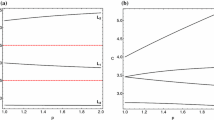Abstract
We consider the particular case of the planar three body problem obtained when the masses form an isosceles triangle for all time. Various authors [1, 2, 12, 8, 9, 13, 10] have contributed in the knowledge of the triple collision and of several families of periodic orbits in this problem. We study the flow on a fixed level of negative energy. First we obtain a topological representation of the energy manifold including the triple collision and infinity as boundaries of that manifold. The existence of orbits connecting the triple collision and infinity gives some homoclinic and heteroclinic orbits. Using these orbits and the homothetic solutions of the problem we can characterize orbits which pass near triple collision and near infinity by pairs of sequences. One of the sequences describes the regions visited by the orbit, the other refers to the behaviour of the orbit between two consecutive passages by a suitable surface of section. This symbolic dynamics which has a topological character is given in an abstract form and after it is applied to the isosceles problem. We try to keep globality as far as possible. This strongly relies on the fact that the intersection of some invariant manifolds with an equatorial plane (v=0) have nice spiraling properties. This can be proved by analytical means in some local cases. Numerical simulations given in Appendix A make clear that these properties hold globally.
Similar content being viewed by others
References
Broucke, R.: ‘On the Isosceles Triangle Configurations in the Planar General Three-Body Problem’,Astron. Astrophys. 73, 303–313 (1979).
Devaney, R.: ‘Triple Collision in the Planar Isosceles Three-Body Problem’,Inventiones Math. 60, 249–267 (1980).
Devaney, R.: ‘Reversible Diffeomorphisms and Flows’,Trans. Amer. Math. Soc. 218, 89–113 (1976).
Lacomba, E., Simó, C.: ‘Boundary Manifolds for Energy Surfaces in Celestial Mechanics’,Cel. Mechanics 28, 37–48 (1982).
Moser, J.:Stable and Random Motions in Dynamical Systems. Princeton (1973).
McGehee, R.: ‘Triple Collision in the Collinear Three-Body Problem’,Inventiones Math. 27, 191–227 (1974).
McGehee, R.: ‘A Stable Manifold for Degenerate Fixed Points with Applications to Celestial Mechanics’,J. Diff. Equations 14, 70–88 (1973).
Moeckel, R.: ‘Orbits of the Three-Body Problem which Pass Infinitely Close to Triple Collision’,Amer. J. Math. 103, 1323–1341 (1981).
Moeckel, R.:Heteroclinic Phenomena in the Isosceles Three-Body Problem, preprint.
Simó, C.: ‘Analysis of Triple Collision in the Isosceles Problem’, inClassical Mechanics and Dynamical Systems. 203–224, Marcel Dekker (1981).
Simó, C., Llibre, J.: ‘Characterization of Transversal Homothetic Solutions in then-Body Problem,’Archive for Rational Mechanics and Anal. 77, 189–198 (1981).
Devaney, R.: ‘Singularities in Classical Mechanical Systems’, inErgodic Theory and Dynamical Systems, Proceedings of the Maryland Special Year, A. Katok (ed.), 211–333, Birkhauser (1981).
Moeckel, R.: ‘Chaotic Dynamics Near Triple Collision’, to appear inErgodic Theory and Dynamical Systems.
Author information
Authors and Affiliations
Rights and permissions
About this article
Cite this article
Simó, C., Martinez, R. Qualitative study of the planar isosceles three-body problem. Celestial Mechanics 41, 179–251 (1987). https://doi.org/10.1007/BF01238762
Received:
Accepted:
Issue Date:
DOI: https://doi.org/10.1007/BF01238762




